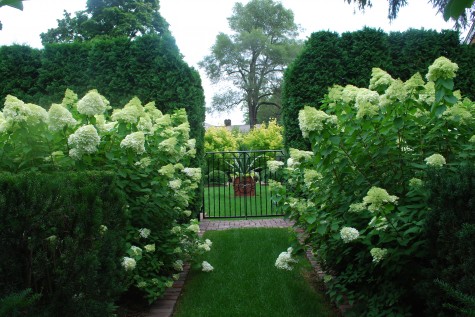
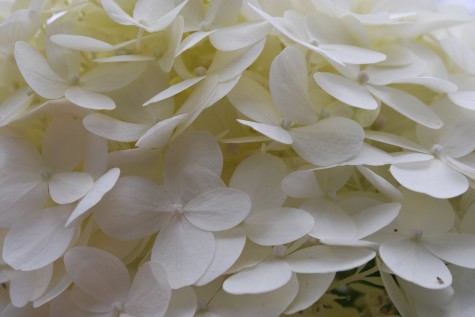
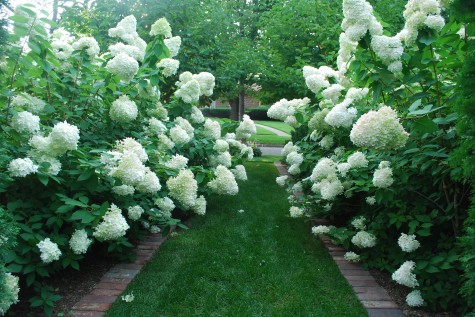
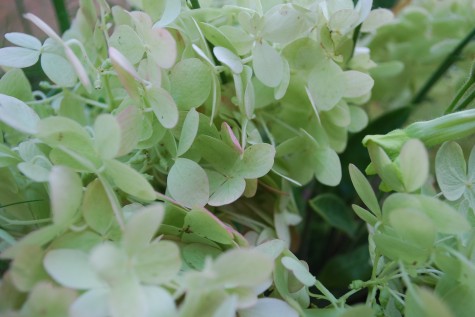

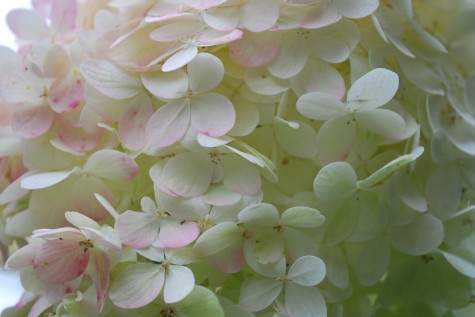
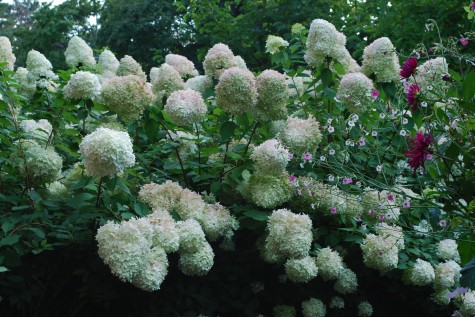
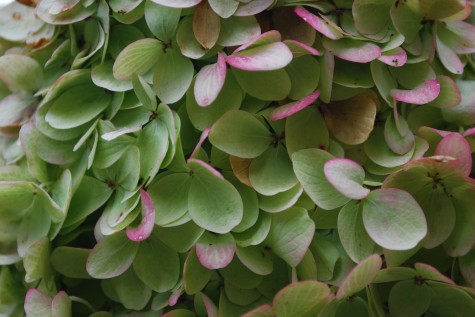
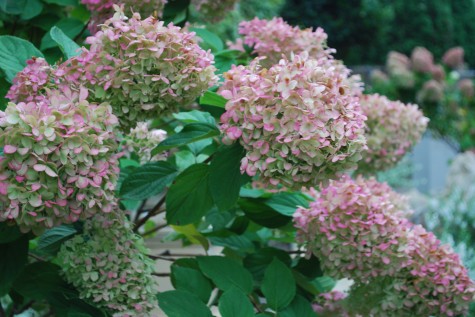
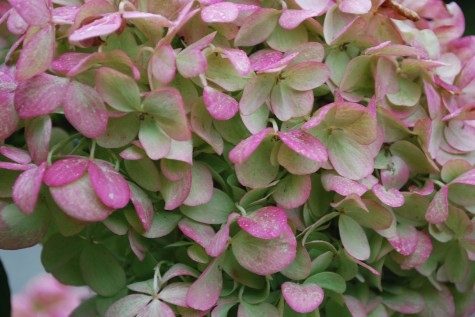

Deborah Silver is an accomplished and experienced landscape and garden designer whose firm first opened its doors in 1986.











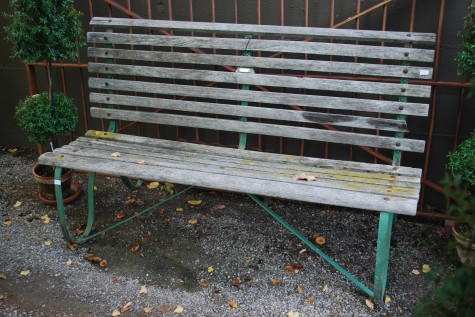 I could easily picture Gertrude Jekyll perched on this old English wood garden bench. Wearing a long skirt, a cardigan, and serviceable brogans, I can hear her in dignified fashion holding forth on some garden design topic or another with as much energy as authority. This straight-backed bench, of slight design and simple materials, is unmistakably English in origin. I have never been to Britain, and I know few people of British extraction-but I have looked at vintage and antique English garden furniture long enough to successfuly guess its origin.
I could easily picture Gertrude Jekyll perched on this old English wood garden bench. Wearing a long skirt, a cardigan, and serviceable brogans, I can hear her in dignified fashion holding forth on some garden design topic or another with as much energy as authority. This straight-backed bench, of slight design and simple materials, is unmistakably English in origin. I have never been to Britain, and I know few people of British extraction-but I have looked at vintage and antique English garden furniture long enough to successfuly guess its origin.
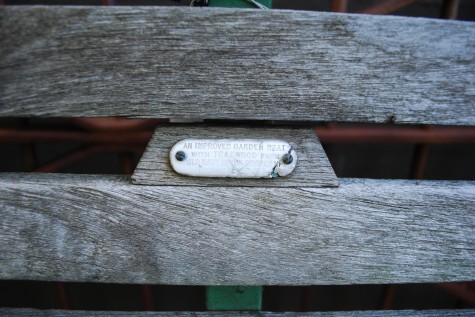
The old porcelain tag on this bench reveals the teak came from decommissioned and broken ships of the Royal Navy. How like the British to recycle disaster and the materials thereof without fanfare. What people designed and made for their gardens was so much a product of who they were, and the culture from whence they came. I have a much tougher time visually determining the origin of new garden ornament. Designers are able to access design and materials from all over the world now. I find some contemporary teak furniture cold and lacking flavor and identity, for this reason.
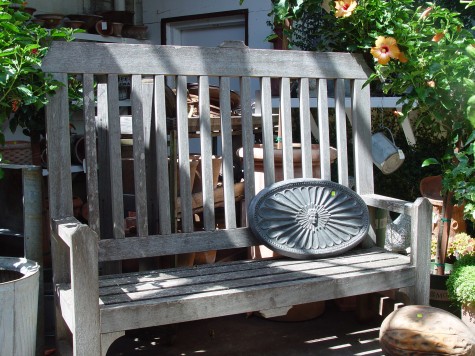 This decidedly English style high backed bench of utterly simple design is a contemporary piece that seems authentic to the culture of its origin. It used to be there were no designers, just craftspeople with good sense about proportion, practicality, and sturdy construction. What worked was also beautiful. This bench doesn’t try too hard. No doubt it will be in service a very long time, given its heft. Its visual heft makes it a good candidate for a special spot in a garden. It could just as easily hold a number of people waiting for a bus, or a pile of kids intent on climbing it.
This decidedly English style high backed bench of utterly simple design is a contemporary piece that seems authentic to the culture of its origin. It used to be there were no designers, just craftspeople with good sense about proportion, practicality, and sturdy construction. What worked was also beautiful. This bench doesn’t try too hard. No doubt it will be in service a very long time, given its heft. Its visual heft makes it a good candidate for a special spot in a garden. It could just as easily hold a number of people waiting for a bus, or a pile of kids intent on climbing it.
 Sir Edwin Lutyens was a British architect of great renown whose practice spanned the late 19th century and early 2oth century. Gardeners all over the world know of him, from his association with Gertrude Jekyll. Her steadfast support of his career, and the projects upon which they collaborated are well documented. The most beautiful bench of his design might be the Hestercombe bench, but the bench most often associated with his name is known as the Lutyens bench. The distinctively curved back and scrolled arms have been the inspiration for subsequent English bench-makers; this version is a beauty.
Sir Edwin Lutyens was a British architect of great renown whose practice spanned the late 19th century and early 2oth century. Gardeners all over the world know of him, from his association with Gertrude Jekyll. Her steadfast support of his career, and the projects upon which they collaborated are well documented. The most beautiful bench of his design might be the Hestercombe bench, but the bench most often associated with his name is known as the Lutyens bench. The distinctively curved back and scrolled arms have been the inspiration for subsequent English bench-makers; this version is a beauty.
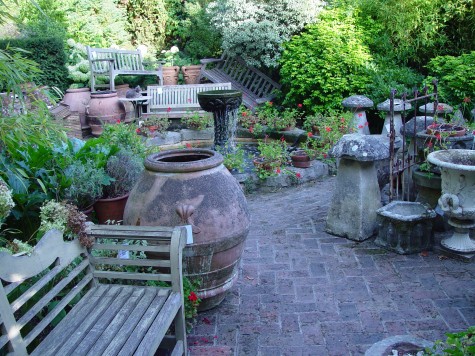 Many of our antique and vintage pieces come from dealers in England. Most of them represent garden objects from of other countries, not just their own. As much as the English gardener of my imagination is keenly interested in plants of all sizes, species and habit, the antique dealers we buy from with are game for anything that might endow a garden with beauty and history.
Many of our antique and vintage pieces come from dealers in England. Most of them represent garden objects from of other countries, not just their own. As much as the English gardener of my imagination is keenly interested in plants of all sizes, species and habit, the antique dealers we buy from with are game for anything that might endow a garden with beauty and history.
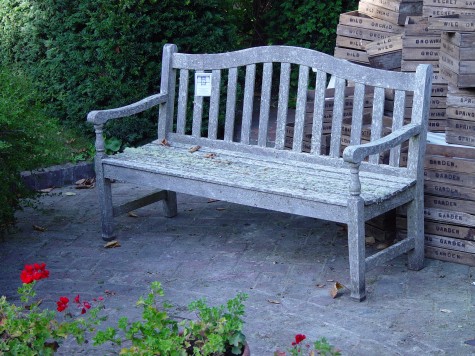 However, one must go to England to find English garden benches. Their modest and sturdy look is so appealing. Even the old benches clearly have many years of service yet to come. A colony of pale green lichens found a home on this bench-no doubt the result of many years of service in some English garden blessed with regular rain.
However, one must go to England to find English garden benches. Their modest and sturdy look is so appealing. Even the old benches clearly have many years of service yet to come. A colony of pale green lichens found a home on this bench-no doubt the result of many years of service in some English garden blessed with regular rain.
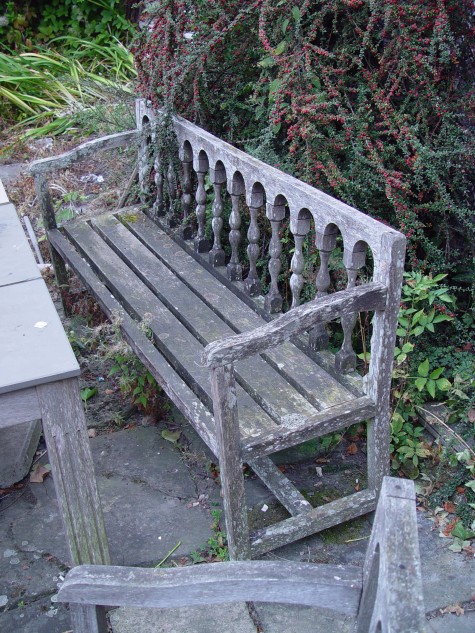 This quietly elegant spindle back bench is likewise mottled with colonies of this lichen and that moss. Its timeworn surface and low key design made it so easy to incorporate into a garden. British wood benches are team players.
This quietly elegant spindle back bench is likewise mottled with colonies of this lichen and that moss. Its timeworn surface and low key design made it so easy to incorporate into a garden. British wood benches are team players.
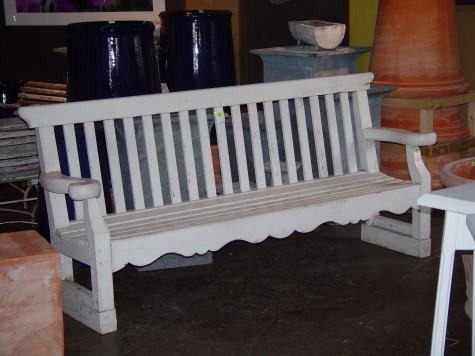 This old painted bench had sustained some dry rot from years of contact with the ground. We stabilized the legs from underneath, and placed it on a gravel terrace. Though 70 years old, I think my clients will enjoy it a good many more years. Painted furniture in a garden has a charm all its own. The frilly skirt and the angled back of this bench is a departure in form from most English benches I have known and loved-but how I like it.
This old painted bench had sustained some dry rot from years of contact with the ground. We stabilized the legs from underneath, and placed it on a gravel terrace. Though 70 years old, I think my clients will enjoy it a good many more years. Painted furniture in a garden has a charm all its own. The frilly skirt and the angled back of this bench is a departure in form from most English benches I have known and loved-but how I like it.
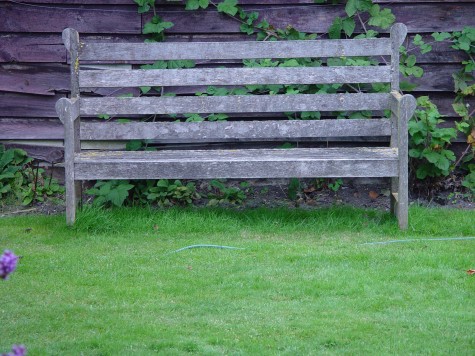
An old bench such as this one could quietly transform the garden into which it were placed. As Mary Keen says, “Nostalgia in gardening often surfaces as a longing for that older, deeper relationship between person and place that we rarely achieve in modern life.”
 There are many species of anemone, but few are quite as lovely as anemone x hybrida “Honorine Jobert. An old garden hybrid discovered in a garden in Verdun France in 1858, it is a star of the fall perennial garden. A good many white flowers are touchy prima donnas that when they are not sulking, perform listlessly. But this anemone shines; it is vigorous, and easy to grow. Though many would say they are best in part shade, I grow mine in full sun on a south wall.
There are many species of anemone, but few are quite as lovely as anemone x hybrida “Honorine Jobert. An old garden hybrid discovered in a garden in Verdun France in 1858, it is a star of the fall perennial garden. A good many white flowers are touchy prima donnas that when they are not sulking, perform listlessly. But this anemone shines; it is vigorous, and easy to grow. Though many would say they are best in part shade, I grow mine in full sun on a south wall.
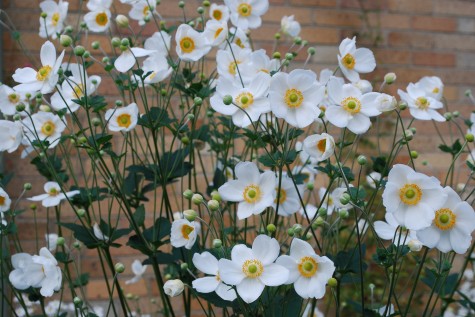
The dark green trifoliate foliage reminiscent of a grape leaf grows about 30 inches tall for me. I have yet to see bugs or disease bother the plants. My criteria for a five-star perennial? Hardiness, ease of culture, handsome in or out of flower, disease and pest resistant, and good for cutting; this plant readily fulfills all my criteria. The flowers are born on very tall wiry dark stems that move gracefully in a breeze.
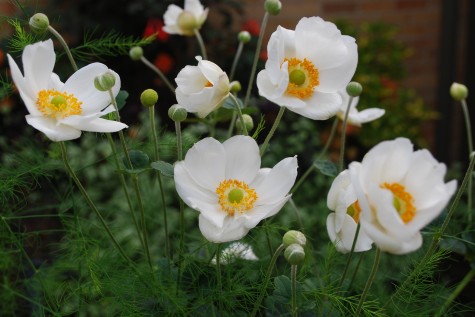 All of the varieties and hybrids of Japanese anemones (which originated in China, by the way) make a great addition to the perennial border. The foliage is dense and low all summer, giving way to impossibly tall flower spikes. The buds dot the stems, and give way to simple 6 to 8 petalled flowers of breathtaking beauty.
All of the varieties and hybrids of Japanese anemones (which originated in China, by the way) make a great addition to the perennial border. The foliage is dense and low all summer, giving way to impossibly tall flower spikes. The buds dot the stems, and give way to simple 6 to 8 petalled flowers of breathtaking beauty.
 The fringed halo of brilliant yellow stamens encircles the lime green stigma-ooh la la. I have only had trouble growing anemones where the soil drains poorly. As I believe that at least 80 per cent of winter hardiness hinges on good drainage, I plant bog plants in poorly drained areas, and work hard to improve the soil in my perennial gardens. These anemones have been here about nine years. I do have to thin them out in the spring, they are that vigorous.
The fringed halo of brilliant yellow stamens encircles the lime green stigma-ooh la la. I have only had trouble growing anemones where the soil drains poorly. As I believe that at least 80 per cent of winter hardiness hinges on good drainage, I plant bog plants in poorly drained areas, and work hard to improve the soil in my perennial gardens. These anemones have been here about nine years. I do have to thin them out in the spring, they are that vigorous.

Anemones are pokey, waking up in the spring. I have been known to run my hoe over their crowns, messing about in the garden too early. However, if I have a mind to move or divide, early spring is the best time. As the fibrous roots root deeply, they take poorly being dug in leaf. They seem not to mind much before they get growing. The best success I have had moving anywhere and anytime I get from the old pink species, Anemone Robustissima. This plant can readily hold its own in a meadow setting, and increase with the speed of a weed. The grey-pink flowers are small and softly colored, and profuse.
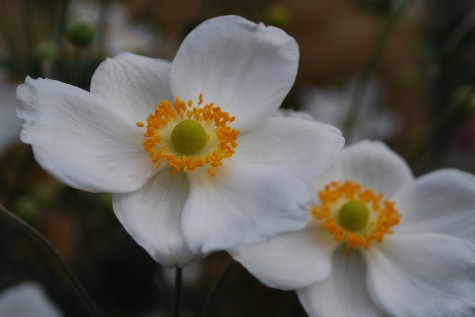
Were I restricted to a palette of less than ten perennials, this one would make my list. I am especially fond of late blooming perennials, and I am never happy about the gardening season coming to a close. I like asters and boltonia for the same reason.

Anemones last well as cut flowers. I like anemones, asparagus foliage, hydrangea and dahlias loosely arranged in a pitcher with whatever else I have going on in the garden. Having flowers to cut all summer long is one of the best reasons to have a perennial garden.

breathtaking-am I not right about that?
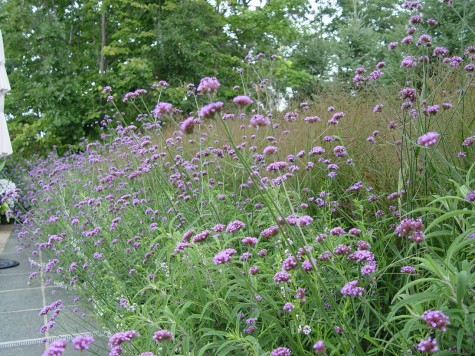
There are those clients that love that grassy, wispy, pastel and herb look. For lack of a better term, I call these my “roadside” weed plantings. As pale and fragile as they appear, they just hit their stride as the summer begins to wind down. Cooler night temperatures don’t faze them one bit. One of my most favorite weedy combinations-the big wispy species, verbena bonariensis, and an ornamental grass.
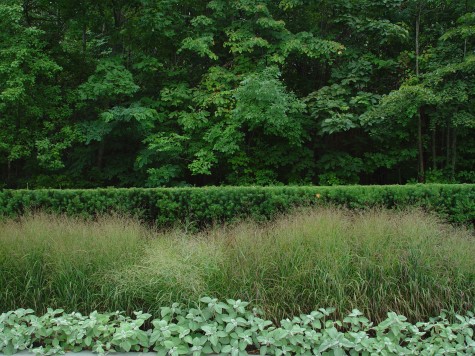 I am a fan of ornamental grasses-espcially the thin bladed wiry types that stand up well. This hedge of panicum virgatum is a welcome textural change from the dark stiffly formal yew hedge pictured above. When I add verbena bonariensis in front of this grass, something good starts cooking. It might very well be that orangy cast typical of a panic grass setting seed; the lavender verbena flowers seem more intensely lavender.
I am a fan of ornamental grasses-espcially the thin bladed wiry types that stand up well. This hedge of panicum virgatum is a welcome textural change from the dark stiffly formal yew hedge pictured above. When I add verbena bonariensis in front of this grass, something good starts cooking. It might very well be that orangy cast typical of a panic grass setting seed; the lavender verbena flowers seem more intensely lavender.
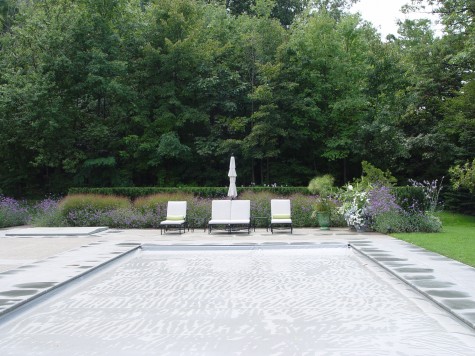 This simple and soft flower/grass hedge transforms a strictly formal evergreen garden for the summer months. Running the entire length of the landscape on both ends of the pool, its cloud-like appearance is on one hand in stark contrast to the modern chaises, and on the other, friendly in feeling and color to the loosely planted pots.
This simple and soft flower/grass hedge transforms a strictly formal evergreen garden for the summer months. Running the entire length of the landscape on both ends of the pool, its cloud-like appearance is on one hand in stark contrast to the modern chaises, and on the other, friendly in feeling and color to the loosely planted pots.
 Alyssum, lavender, silver posie thyme and tricolor sage make a pale ruff around a blue foliaged escheveria in this old stone box. The peach flowers of the echeveria-a bonus. Though delicate in appearance, these plants are drought and frost resistant. It interests me that something so fragile in appearance can withstand hit-and-miss care. Plant combinations such as this one are as foolproof as they come. Deadhead the lavender, and shear the alyssum once in a while-that’s all. Their only enemy-too much water.
Alyssum, lavender, silver posie thyme and tricolor sage make a pale ruff around a blue foliaged escheveria in this old stone box. The peach flowers of the echeveria-a bonus. Though delicate in appearance, these plants are drought and frost resistant. It interests me that something so fragile in appearance can withstand hit-and-miss care. Plant combinations such as this one are as foolproof as they come. Deadhead the lavender, and shear the alyssum once in a while-that’s all. Their only enemy-too much water.
 jjThere are other grey foliaged plants that are just as rugged. Though I am not so fond of the cut-leaf annual dusty miller, the paddle shaped leaves of cirrus dusty miller I find very appealing. The texture of simple shaped leaves, repeated in a smaller version with the silver helicrysum, is a great contrast to the needle foliaged icicle plant. The saucy and ferny foliaged plant in the center-a silver centaurea. Only the white nicotiana in this basket would fuss if you forgot to water.
jjThere are other grey foliaged plants that are just as rugged. Though I am not so fond of the cut-leaf annual dusty miller, the paddle shaped leaves of cirrus dusty miller I find very appealing. The texture of simple shaped leaves, repeated in a smaller version with the silver helicrysum, is a great contrast to the needle foliaged icicle plant. The saucy and ferny foliaged plant in the center-a silver centaurea. Only the white nicotiana in this basket would fuss if you forgot to water.
 The trailing plant front and center in this pot-showy oregano. Though they show poorly in pots early on, they fill out beautifully. The papery bracts are the palest green, lavender and peach.
The trailing plant front and center in this pot-showy oregano. Though they show poorly in pots early on, they fill out beautifully. The papery bracts are the palest green, lavender and peach.
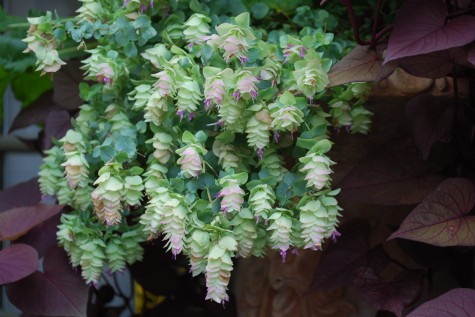
Once you have seen Kent Beauty oregano, you will want to grow it.
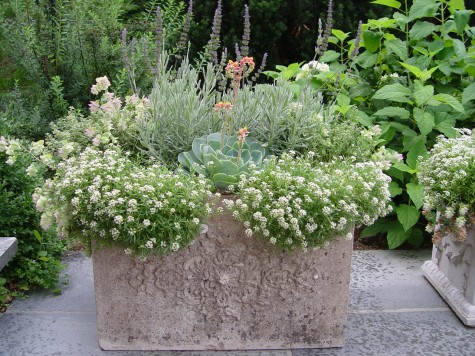 These plants are fairly diminuitive growers, so not so much grooming and shaping is necessary. Though it is late summer, no plant is overgrown, or threatening the well-being of a neighbor. This pot has shown well the better part of four months.
These plants are fairly diminuitive growers, so not so much grooming and shaping is necessary. Though it is late summer, no plant is overgrown, or threatening the well-being of a neighbor. This pot has shown well the better part of four months.
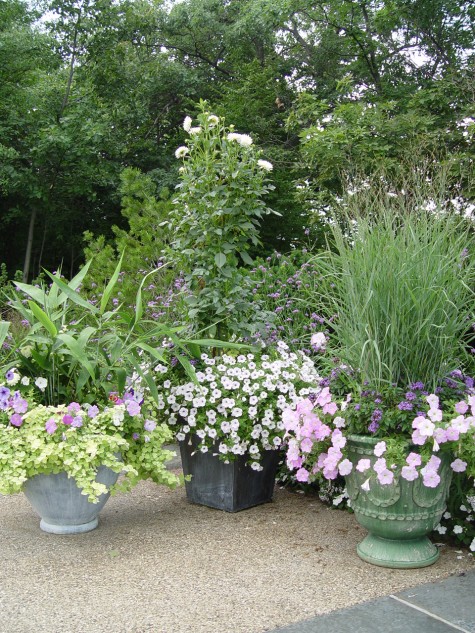
The big pots have grass, a broad leaved bamboo, and a tall dahlia as centerpieces. The pastel petunias have that same loose weedy look as the grassy beds. One would never suspect this planting was photographed in late September. This pleases me, as I so hate to see a season come to a close.
Deborah Silver is a landscape and garden designer whose firm, Deborah Silver and Co Inc, opened its doors in 1986. She opened Detroit Garden Works, a retail store devoted to fine and unusual garden ornament and specialty plants, in 1996. In 2004, she opened the Branch studio, a subsidiary of the landscape company which designs and manufactures garden ornament in a variety of media. Though her formal education is in English literature and biology, she worked as a fine artist in watercolor and pastel from 1972-1983. A job in a nursery, to help support herself as an artist in the early 80’s evolved into a career in landscape and garden design. Her landscape design and installation projects combine a thorough knowledge of horticulture with an artist’s eye for design. Her three companies provide a wide range of products and services to the serious gardener. She has been writing this journal style blog since April of 2009.
Copyright © 2024 · Deborah Silver & Co. · Detroit Garden Works